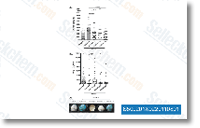We then aligned the reads towards the human genome. Mutascope calculates the error charge for each position/substitution/strand group at positions which are not database of single nu cleotide polymorphisms positions and uses this to calculate the binomial probability of mutations while in the tumor distinguishing somatic from germline working with an additional Fisher exact test. Last but not least, very likely false positive mutations had been filtered out working with coverage bias, read group bias, ambiguity of alternate al lele, mapping good quality, alternate allele top quality, proximity to an indel, or to a homopolymer. Copy number alterations The common amount of reads per gene was calculated for every sample sequenced. We then computed the indicate and standard deviation with the normalized coverage while in the germ line DNA for every patient at every gene.
The significance of amplification or deletion selleck custom peptide synthesis of the distinct gene during the tumor DNA was estimated by evaluating the tumor normalized coverage to the distribution of ordinary normalized coverage at this gene for all individuals, employing the R function pnorm. Fol lowing the Bonferroni correction for numerous testing, we re ported amplifications and deletion occasions with P five. 6 ? ten six. Variant annotation Variants were queried against dbSNP135 to find out novel or known variants. We upcoming utilised snpEff version 2. 0. 5 in combination with GATK VariantAnnotator, each with default parameters, to recognize the various practical impacts on coding genes. We enriched this annotation by cross referencing the checklist of variants to your dbNSFP database, which provides con servation, practical prediction, also as Uniprot codon change infor mation.
Last but not least, we annotated the variants for presence in Catalogue of Somatic Mutations in Cancer v61 based on coordinate and genotype. Notably, we utilised Catalogue of Somatic Muta tions in Cancer codon numbering selleck when discordant quantity ing was reported in between databases. Benefits We collected 38 tumors, together with two lobular invasive car cinoma, 35 ductal invasive carcinoma and a single Ductal Carcinoma In Situ. Not ably, four tumors had cellularity reduce than 20% and 6 tumors have been Her2 optimistic as determined by stand ard testing. We assembled a panel of 47 genes to analyze these speci mens using UDT Seq. The genes had been chosen for his or her clinical value or their relevance to breast cancer genet ics and treatment.
The coverage resulting in the sequencing from the 1,736 amplicons from 38 pairs of tumor DNA and germline DNA was deep, sensitive and remarkably uniform in agreement together with the published specifi cations of microdroplet PCR, which provides large high-quality information for clinical sequencing. Chromosomal alterations The precise  allelic fraction measured at every sequenced position by UDT Seq may be reflective on the prevalence of the mutated clone from the tumor sample, but also can re sult from chromosomal losses or gains.
allelic fraction measured at every sequenced position by UDT Seq may be reflective on the prevalence of the mutated clone from the tumor sample, but also can re sult from chromosomal losses or gains.
PAFR Signal
PAFR has won the GFOA
